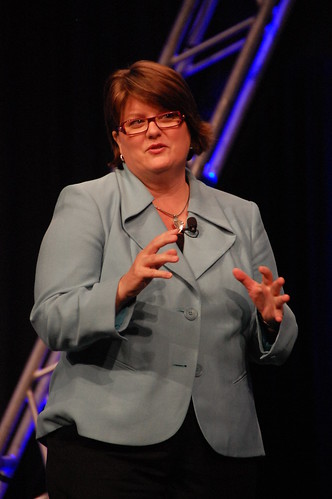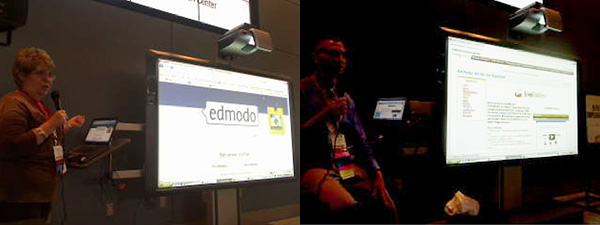ISTE 2011 Virtually: Day 3-4
First things first, I am definitely going to ISTE 2012! While I was able to follow along virtually and participate online in the ISTE Unplugged sessions, the thing I wasn’t able to do is meet all of the wonderful people in my PLN that inspire me daily. I want that experience next year!
Starting With The End
I followed the closing keynote of ISTE 11 on Twitter and wished that I was sitting in that room or that I was able to see it live. Unfortunately, I wasn’t there and it wasn’t being streamed on the web, but now it’s online so that I (and you) can watch it.
Watch this – Chris Lehmann is amazing!
At about minute 24 in the video, Leslie Conery (ISTE’s Deputy CEO) asks the audience “What is it that you’re going to do next?” She then goes on to say “get it out of your brain” and she challenges the audience to tweet, write down, text two goals that you are taking away from ISTE 2011. At that point, the twitter stream was going too fast to even try to keep up with everyone’s goals!

So, what are my two goals?
- Set up Edmodo for at least Grades 4-7. I’ve decided that it’s a better option for what I want to do than Collaborize Classroom though if I have time I may try this site with a few select classes too.
- Find (or start) online collaborative projects (preferably global ones) for all of the grades. I had some successes and some learning experiences (don’t want to call them failures) with that this past year and will blog about it at some point.
- Okay I know I said two but … I have a third (and more but I’ll stop at #3) which is to take the time to explore all of the things that I saved to Diigo or added to my notes or that I find as I read follow up blogs, etc.
My Day 3 & 4 Learning
Once again, I spent a lot of time at ISTE Unplugged and came away inspired by what people are doing and thinking about how I want to approach certain things next year. Here’s just a little of what I took away from the sessions I attended. The archives of all of the ISTE Unplugged sessions are now (or will be) available so if any of these interest you, you should go watch the archive!

Inspire Creative Writing with Online Discussions by Caitlin Tucker & Blended Learning: Differentiate Instruction and Bring Science to Life by Colt Briner
These were both sessions about Collaborize Classroom. I was very interested to hear how they were using or recommended using this platform. I loved the ideas of having students share writing and give feedback to one another on their work. I was impressed with the examples shown in this session and may try Collaborize Classroom with 7th or 8th grade this coming year but I still think that for what I want to do that Edmodo is probably a better fit.
Bringing Books to Life by Bob Greenberg
Amazing stop-motion animation videos from 2nd Graders! I need to stop thinking things like they’re too young for things like that and try some of these with some of my students next year even the younger ones. There are lots of ideas running around my brain right now about using stop-motion animation like this and paper slide videos and flip book animations using PowerPoint or other tools. I would like these to be tied into the curriculum though and not just animation with no purpose. I like the idea of retelling books they’ve read or tying these into Social Studies or Science somehow. I need to talk to some of the classroom teachers about this to see where they think the best fit might be.
Movie Magic by Josh Stumpenhorst
I first discovered Josh’s blog when he did the You’ve Got a Friend in Me lip dub video so I was excited to see him on the list of presenters. I hadn’t realized that Josh used PCs & PC tools – yeah! Usually all the cool tools shown are for Macs and I have to try to find alternatives for the PC. The examples in Josh’s Prezi are great. I really love the first one in the Authentic section about lockers. Lockers can cause such angst for 6th graders. I would really like to get into some green screen projects but haven’t really explored it much yet. The tutorial on Josh’s blog will come in handy!
Flipped Classroom Model: The Full Picture by Jackie Gerstein, Ed.D.
Interesting thoughts on the flipped classroom from Jackie – watch the archive to see where she stands on this. Unplugged sessions are quick so I’m definitely going to review Jackie’s presentation and learn more about the different models of learning she discussed. I still think that flipping some things is a great idea as long as all students have access to computers and the Internet at home. I have been toying with the idea myself. Why should I take 15 minutes of a 30-45 minutes class to explain how to do something? The students could learn that at home with a video before class and come in ready to actually do something instead of learning how to do something for 1/4-1/2 of the class.
Creating eBook – eContent with ePub format to support your curriculum or your flipped classroom by Helen Lazzaro and Tricia Lazzaro
I am very excited about having some of my classes creating eBooks and was thrilled to know that ePub is rolling out an education option! I had already planned on doing more writing with students this year and this will be a great way to not only have them write but to have them publish their work. I definitely am going to spend some time setting up accounts for my students and playing with the creation of books with ePub before school starts and since we use Chrome as our browser at school, they’ll be able to read them online.
Unbelievable Elementary Technology Projects by Brad Flickinger
Wow, amazing ideas and amazing work by students from Bethke Elementary. The movies created by the 5th graders are terrific. I would love to get into movie making more with some grades. Right now I only have 2 Flip Video Cameras and we would need to change some things in order to be able to share video of the students online. I’d love to pick up some Lego Robotics at some point but I don’t think that will be happening for at least another year. I intend to use some of the examples from this school to show my students that yes, students you age can do these things!
Empowering Students to Take Charge of Their Learning by Jason Schrage
It is always so helpful to see how people are using tools with their students and that’s just what Jason did. Jason showed how he uses LiveBinders with hist students and how his students use them too! Next year, I will be doing more research projects with students and think that using LiveBinders to collect the information might be a good solution. If you have been wondering how to use LiveBinders with students check out Jason’s session and his presentation binder.
Social Media in the Classroom by Elaine Plybon
One interesting point that Elaine brought up is that many people are getting fired or having problems at work from inappropriate use of Social Networking sites. Because of this, Elaine is trying to show her students how to use Social Networking responsibly. This point made me wonder. Many educators are using Social Networking sites in the classroom and many times this is because the students are already using them so their teachers are trying to meet them where they are. Is this going to cause our students more problems in the workplace? Might they not think that since their schools adapted to them, their workplaces will too.
Going Global: One Classroom’s Journey by Ben Curran
I was so inspired by Ben’s ideas and what he did in his classroom this year to connect his students globally. It’s hard to believe that Ben got started just after attending the ISTE Conference in 2010. This session contained lots of practical advice on how to get started and some great examples of what can be done. I am especially interested in learning more about and possibly joining the Challenge 20/20 Program but I would need the participation of the classroom teacher also to make this a cross curricular project so it may need to wait for the 2012/13 school year.
CIPA and COPPA – Fighting Internet Filters and Those “No One Under 13” Restrictions by Mark E. Moran
Mark had a lot of good information on both of these in his presentations (CIPA & COPPA). We’re not really impacted by these at our school because we don’t get any Federal funding but I was interested in what Mark had to say. I am working on a presentation for parents on Digital Citizenship and wanted to bring in some things about both CIPA and COPPA. The big problem that we have at school is students under 13 that are on Social Networking sites – mostly Facebook. As Mark pointed out, it’s not illegal; it’s just going against the Terms of Service of the website. I’m just afraid that if I say it’s not illegal that even more of my 2nd & 3rd Grade students will have Facebook accounts. I plan to emphasize that it’s teaching our kids to lie and that morally and ethically that’s not what we want to teach our kids.
Technology, autonomy and healthy adolescent development by Jamie Steckart
I decided to attend this session because the title of it interested me and reminded me of my friend Stephen Davis. I love the ideas on letting the students take charge of what and how they will learn. Jamie pointed out that in most cases Kindergarten students have more autonomy than High School students. That does seem rather crazy, doesn’t it? Jamie’s school is amazing. What’s even more amazing is that they can do all that they do with the small class sizes and expeditions that do not require additional money from the students using the standard amount of money that a school gets from the state. If this school can do it, why can’t every school?
Whew, and that’s only some of the sessions I attended! I would like to say a big thank you to Steve Hargadon for providing ISTE Unplugged for those of us unable to attend ISTE 11. I truly appreciate the opportunity to learn and to be part of it all.

Reading all of this I realize that I have a lot to do this summer and the learning opportunities aren’t over yet either! Here’s what I have coming up this summer:
- Reform Symposium Conference 3 -This is an online conference from July 29th-31st. You should check it out too!
- Rock Star Teacher Summer Tech Camp – I’m going to this one from August 2nd-4th and you can too! Last I checked there were still a few spots left.
- EdCamp SFBay – It’s free. It’s teacher directed. It’s in the San Francisco area. I’ll be there on August 20th. Will you?
- And, of course, reading all the blogs about the ISTE 11 & watching the videos from Video on Demand sessions